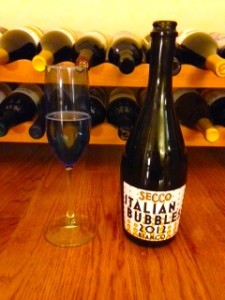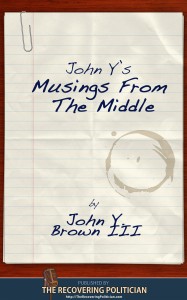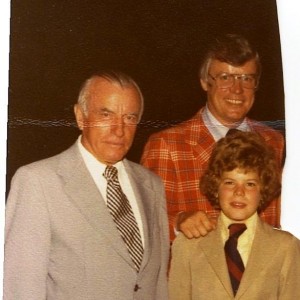By John Y. Brown III, on Tue Dec 31, 2013 at 12:00 PM ET
 Thought for the day (Perception and problem solving) Thought for the day (Perception and problem solving)
When faced with a new and unpleasant predicament I like to think of the best part about it, the worst part, the slver lining and the reality of the entire situation.
For example, today I am congested and have a cold.
Best part: I can sound like Barry White when I talk to my wife.
Worst part: My wife keeps clear of me while I am contagious.
Silver lining: Sometimes I fully recover from my cold and am no longer contagious before my voice completely heals and I can sound like Lou Rawls for a couple of days when I talk to my wife. (Lou’s voice isn’t as deep as Barry’s was but still sounds low, slow, melodic and smooth.)
The reality of the entire situation: It’s too bad I can’t sing with or without a cold.
Now, that doesn’t necessarily mean I should take singing lessons instead of taking Advil. It only means I should at least seriously consider that option.
By Liz Roach, on Tue Dec 31, 2013 at 10:00 AM ET  What is it about Champagne that so aptly embodies New Year’s Eve? Is it the effervescence, the silky luxury of a liquid that personifies decadence? What is it about Champagne that so aptly embodies New Year’s Eve? Is it the effervescence, the silky luxury of a liquid that personifies decadence?
Is it the exoticism of a wine that most reserve for special occasions?
As surely as sequins and “Auld Lang Syne,” you will see gallons of the beverage imbibed on this night.
Perhaps it’s because New Year’s provides one last chance to indulge in a spell of revelry before settling into the quiet sobriety of winter resolutions.
Whether you’re hosting a New Year’s dinner party or just want a toast-worthy drink to pour before hitting the bars, it’s a good opportunity to brush up on your bubbly knowledge.
Of course, legitimate “Champagne” only originates in the region of France by the same name. All other bubblies are actually sparkling wines, and there are many interesting choices. California makes some excellent versions, as do Washington state and Virginia.
 For inexpensive but lively European sparklers, try a Spanish Cava or a German Sekt. The Italians offer an array of fabulous sparkling wines, from the dry Prosecco to the sweeter Asti. There are also fizzy Shirazes, Rosés, and Lambruscos, all of which set a festive tone for merrymaking. For inexpensive but lively European sparklers, try a Spanish Cava or a German Sekt. The Italians offer an array of fabulous sparkling wines, from the dry Prosecco to the sweeter Asti. There are also fizzy Shirazes, Rosés, and Lambruscos, all of which set a festive tone for merrymaking.
Sparkling wines are famous for their versatility with food pairings. A dry type complements everything from foie gras to spicy curry to apple pie. It’s also wonderful on its own. Save the sweeter kinds for before or after dinner, as they can overwhelm the palate and diminish the taste of many dishes.
As you’re perusing the Champagne aisle of your local wine shop, keep in mind the dryness vocabulary. From driest to sweetest, the range is Extra Brut, Brut, Extra Sec, Demi-Sec and Doux.
Ready to rollick? Here are a few picks to kick-off this boisterous night.
For a semi-sweet Italian sparkler, try: Martini & Rossi Asti.
For a fruity, Californian sparkling wine, try: Schramsberg 2009 Brut Rosé
For less than $10, this dry Cava is an absolute steal: Jaume Serra Cristalino Brut.
For classic French Champagne from a storied brand, go for: Taittinger Brut Reserve NV.
Cheers to a fantastic year and to many new memories in the making!
By Erica and Matt Chua, on Tue Dec 31, 2013 at 8:30 AM ET “Going where no man has gone before” is every adventure traveler’s dream. Sadly though it isn’t possible. Unless you explore the deep seas, there are very few places a person can go and be the first. We travelers like to imagine ourselves discovering something new, doing something that has not been done before, but the reality is that we’re just going where others have stood before. While the places we go may impress our geography challenged friends or our ninety-year old Great Aunts, there are no roads not traveled. It’s awesome to be among the few to have visited North Korea and Antarctica, but as Shania Twain would say, “it don’t impress me much”. The most impressive places are those where you share experiences, make friends, which, consequently, draw many other tourists. The Salar de Uyuni, a must-see on the South American Gringo Trail is one of those over-touristed, wonderful, experiences.

Situated on Bolivia’s border with Chile, the Salar de Uyuni is a well traveled 3-day tour that typically starts in one country and ends in another. It is a common destination shared by South American backpackers as “everyone” does it. Why does everyone go here? Crazy photos created by the reflecting salt flats and the dry atmosphere. The curiosity that the Salar de Uyuni is the world’s largest salt flat doesn’t draw tourists…it’s the cool photos.

Americans have to pay a “reciprocity fee”, which can be done at the end of the tour. Until then we were the responsibility of the tour company, which found it easiest to put us all in one Landcruiser. Two Brits decided to come along with us, because, well, let’s be honest: Americans are pretty awesome.
Read the rest of…
Erica and Matt Chua: The Gringo Trail — South America
By John Y. Brown III, on Mon Dec 30, 2013 at 12:00 PM ET
 Click here to purchase his first book My second book and the fear of too much success.
I almost have enough new posts to put out a second book of Musings from the Middle before Christmas. But am not sure I have the time to risk having a blockbuster best seller.
It made me think of the time as a teenager I was shooting craps with friends and had failed to roll a pass for 10 consecutive rolls.
My logic before doubling down my bet for the 11th roll was “Since I had failed to roll a pass 10 times in a row I had much greater than usual odds to succeed on my 11th roll.” But I didn’t and lost my last dollar.
Later a math teacher explained to ne that if I flipped a coin 10 times in a row and it was heads each time on the 11th flip it would still only be a 50-50 chance of it being tails. I never liked that math teacher and always thought he was overly pessimistic about life.
 So since my first book only has sold in the very high two digits (almost low three digits) and is ranked, like, two trillionth in sales rank on Amazon.com my old logic is returning and telling me if the first book was a complete sales failure the chances of a second book being a great success is pretty much guaranteed. At least if you look at the numbers, understand my logic, and have an optimistic mathematical view of the world, unlike my former math teacher. So since my first book only has sold in the very high two digits (almost low three digits) and is ranked, like, two trillionth in sales rank on Amazon.com my old logic is returning and telling me if the first book was a complete sales failure the chances of a second book being a great success is pretty much guaranteed. At least if you look at the numbers, understand my logic, and have an optimistic mathematical view of the world, unlike my former math teacher.
Sometimes you just have to go for it and take the risk in life even when logic dictates you won’t have the time to handle your overehelming success. Just do it anyway and figure it out later.
And besides, what’s the worst that can happen? Sales jn the high two digits again? Heck, that would only means a third book would likely be a sure NY Times best seller.
By RP Nation, on Mon Dec 30, 2013 at 10:00 AM ET In 2012, just prior to the November presidential election. I wrote in RP, a closing argument on behalf of my chosen candidate, Jill Stein of the Green Party. I asked readers to try to imagine a political party really wanting America governed progressively. Imagine its platform stressing the environment, social justice, human and civil rights, peace. and disarmament. I had concluded, the two-party duopoly, may claim they support advancing these values, but the truth, upon closer analysis, proves they do not.
The election results showed only about 1.8% or 2.3 million of the combined popular vote were cast for any third-party candidate. All third-party campaigns had been predicting a better turnout than in the past, but like most, I knew, at this time, a third-party candidate would not win the election. Nonetheless, I felt good about my pragmatic and principled vote for Jill Stein.
The control exerted by the present two-party duopoly leaves third-party candidates little hope of being elected to a major office, until fundamental changes in our electoral process occur. Such candidates have continued to run and by doing so, have influenced election outcomes while often shifting national conversation.
 The question remains, has anything changed in America since the 2012 presidential election, which would improve third-party chances in the future? Do the majority of Americans, regardless of party affiliation, think a capable and robust third-party is needed? The question remains, has anything changed in America since the 2012 presidential election, which would improve third-party chances in the future? Do the majority of Americans, regardless of party affiliation, think a capable and robust third-party is needed?
The Gallup organization, for the past 10 years, has been asking this question. In October 2013, they reported their latest’s poll results. Perhaps it was a surprise to some, but voters polled have said “yes!. The majority of Americans, now believe a major third-party is needed.
Presently, Americans see dysfunction, by both political parties, in the way government works is within a point of it’s all time low, suggesting, Americans are fed up with the way the major parties are handling things, even going as far as saying the best solution is a major third-party initiative in 2016.
Lookin at the numbers: 26% of Americans say the two major political parties are doing an adequate job, yhgt 60% say the two major parties are doing such a poor job that a third party is needed. Is that a big change from previous polls? Not really, although that 60% the highest Gallup has ever seen on this question over the last ten years.
Also, for the first time in U.S. history, Gallup found, given the inability of the Republican and Democratic parties to agree on the most basic of government functions, 52% of Republicans and 49% of Democrats believe a third party is needed to adequately handle today’s problems. Expectantly, 71% of independents support a third-party initiative.
How about other demographics? You might expect young voters to favor a third-party. You would be wrong! Young voters, aged 18 to 29, perhaps due to difficulty finding a job paying a living wage, the pressure of going to college, then trying to payoff exorbitant college debt has caused them to take their eye off of politics. According to Gallup, this demographic polls the highest, saying the current system is OK. It’s the 50 to 64 year olds, probably worrying about healthcare, Social Security and Medicare who most want a third-party choice.
Also, what about the idea of divided government? Most of us, along with some pundits and commentators, have come to the conclusion having divided government, as it is now, with the Presidency and Senate controlled by the Democrats and the House of Representatives by the Republicans lead to the kind of paralysis we are seeing in Washington. But, the Gallup poll found there is no pent up demand by the American public for one-party control of all three branches. It is just the opposite.
25% say it is better for the country to have the same party in control of the Presidency and Congress,
38% say the political party of the President and the Congress makes no difference, and 28% say it is better to have the President and Congress of different parties. Matter of fact that 25% is, by a few points, the lowest interest in having a single party government in the 10 years the Gallup organization has been conducting this poll.
Similarly, according to a new CNN/ORC poll, the current Congress is not just bad, it is terrible. Two-thirds of Americans think it is clearly the worst Congress in their lifetime.
CNN wrote: “That sentiment exists among all demographic and political subgroups. Men, women, rich, poor, young, old, all think this year’s Congress has been the worst they can remember,” “Older Americans, who have lived through more congresses, hold more negative views of the 113th Congress than younger Americans”.
Amazingly, despite the terrible results of these two polls, well over 85 percent of the current members of Congress are expected to be re-elected in 2014! Upcoming columns will explore the question, is there not something wrong with the design of an electoral system when the connection between job performance and election outcome can be so weak?
Just hope and desire for a third party is not sufficient to ensure there will be another successful one. Unfair structural factors contrived by the two-party duopoly for the presidential and congressional elections and the parties’ own abilities to deceitfully, yet skillfully, adapt to wavering public opinion and preferences, then altering their campaigns, helped the Republican and Democratic parties remain the dominant parties for more than 150 years. Emerging third parties have challenged their dominance but not been able to sustain any degree of electoral success.
All hope for a third-party presidential victory may not be lost. It has happened before in U.S. history. Do you know which President was the last successful third-party candidate?
===
Gary Yarus is a student of political movements, a progressive populist, a Green Party pro-democracy advocate and the curator of an online magazine, covering democracy, ecology, peace and social justice called “The Beacon” ( http://bit.ly/TheBeacon ). Email: gyarus@me.com
By Saul Kaplan, on Mon Dec 30, 2013 at 8:30 AM ET Maybe we need to bang together the heads of mad scientists and mad designers.
If we are waiting for randomized double blind studies to tell us how to address the big social system challenges of our time including health care, education, and energy we will be waiting a very long time. That is not how we will transform these systems. It will take passionate exploration, which is more iterative than traditional scientific methodology. It will take design thinking and process combined with powerful storytelling to create novel networked systems to deliver the value we need and expect in the 21st century. We need to try more stuff.
Last week I spoke at the Business of Aging: Ontario Innovation Summit in Toronto. It was a great event attended by many innovators from across the public and private sector. Attendees all shared a passion for focusing innovation on the opportunity emerging as the silver tsunami of an aging global population rapidly approaches. I shared my point of view on the need to do R&D for new business models and systems and our work at BIF in the Elder Experience Lab. As I always do, I blathered on about design and storytelling tools as the key enablers to system change, in this case developing age friendly environments and communities.
The reaction was largely positive but during a panel discussion I was reminded that many are still stuck on a perceived conflict between design thinking and analytical thinking, between design process and scientific method. They are not mutually exclusive. We need to apply our opposable minds to borrow from both approaches to design new systems while measuring what works and is most likely to scale.
 I was asked by summit organizers what I thought would be the most important innovation to enable an age friendly society by 2020. I replied: I was asked by summit organizers what I thought would be the most important innovation to enable an age friendly society by 2020. I replied:
Perhaps the most important innovation for an age-friendly society by 2020 does not require inventing anything new at all. Maybe it just requires all of us to reexamine our assumptions about the elder experience and ways to enhance it. Innovation is a better way to deliver value, in this case, designing environments and systems that enable elders to age in their own homes and communities with dignity. The innovation may be nothing fancier than bringing the voice of the elder directly in to the conversation and designing a better experience recombining existing capabilities and assets in new ways to serve the needs of society’s elders.
Most of today’s innovation conversation is through the lens of the institutions that comprise the current elder care system. The elder’s voice is missing. Tweaking the current system will not work. Adding technology to the current system will not work either. We need to design new system approaches to enhance the elder experience and to prepare for the imminent silver tsunami of baby boomers that will bring a completely new set of expectations and desires to the age-friendly conversation.
It is not technology that is getting in our way. We have more technology available to us then we know how to absorb. It is humans and the institutions we work in that are both stubbornly resistant to change. Rather than applying technology in a sustaining way to try and improve the current institutionally based elder care system we need to experiment with technology as a disrupter to enable new system approaches that enable elders to age in place. We need system level innovation designed around the elder to create environments and care models that enable a more age-friendly society.
It is odd for me to represent design thinking and process in the debate when my training is as a scientist and MBA. The reason I hang around so many smart designers is that I don’t think the old tricks alone will enable the system change we need. We need to borrow from both approaches to pave a new way. It is messy but necessary. Lets bring together the mad scientists and mad designers and see what happens.
By John Y. Brown III, on Fri Dec 27, 2013 at 12:00 PM ET  JYB Sr., JYB Jr. and JYB III circa 1972 My favorite –and perhaps most emblematic—story about my father when he was a child.
When John Y Jr was about 16 months old or so, my father hadn’t quite taken to walking yet. He probably didn’t see the point when everyone around him seemed so willing to carry him everywhere he needed to go. But that’s beside the point.
His slow visual and motor development was beginning to distress my grandmother, so she and my grandfather took my 16 month old father to a psychologist to test his responsiveness, perception and ability to navigate his surroundings.
For the first test the doctor laid out a soft blue blanket and put the 16 month old John Y Jr at the center of the blanket. The doctor then placed an eye-catching and appealing shiny red ball on one of the blanket corners several feet away from my father to see if he would notice the ball and then crawl to it and retrieve it to play with.
 My father, sitting in the middle of the blanket, eyed the bright red ball several feet away and reached down beside his little legs and grabbed a fistful of the blanket and started pulling the ball to toward him. My father, sitting in the middle of the blanket, eyed the bright red ball several feet away and reached down beside his little legs and grabbed a fistful of the blanket and started pulling the ball to toward him.
And then picked up the ball while never moving himself and began playing with it.
The doctor sent my grandparents home and told them not to worry; their son was fine.
By John Y. Brown III, on Fri Dec 27, 2013 at 12:00 PM ET Travel advice for intelligent life on other planets.
If there really is extraterrestrial life out there and they are aware of planet Earth and have beeen monitoring us and waiting for the right time to visit, there really is no better time of year better to visit our planet than around Christmas time and the entire holiday season.
Homes and businesses are decorated with bright colorful lights and our people are in a pleasant, gracious and friendly frame of mind–toward everyone, even strangers.
 Granted, traffic can be bad and the weather is cold but, on the whole, as a planet, we are at our very best during this time of year. Granted, traffic can be bad and the weather is cold but, on the whole, as a planet, we are at our very best during this time of year.
And if you are savvy about it, you can find some real bargains for lodging, food and entertainment.
By Julie Rath, on Fri Dec 27, 2013 at 8:30 AM ET Few things are worse than getting caught in the rain in your dress clothes. Especially if you’re on the way to work, and you know you’re going to spend much of the day in wet clothes until your outfit dries. My suggestion: check the weather before you get dressed, and make sure your wardrobe includes rainy weather gear. Below is my list of must-haves for soggy days:
 Raincoat – I spend a lot of time in peoples’ closets, and I’ve seen some pretty awful windbreakers masquerading as rain gear. Bad weather is no excuse to look drab and unstylish. Pull it together with a sharp raincoat. Two great options are a classic trench, or a more modern mac (above left and right). If you wear suits or sportcoats everyday, buy in a size that will fit over them. Raincoat – I spend a lot of time in peoples’ closets, and I’ve seen some pretty awful windbreakers masquerading as rain gear. Bad weather is no excuse to look drab and unstylish. Pull it together with a sharp raincoat. Two great options are a classic trench, or a more modern mac (above left and right). If you wear suits or sportcoats everyday, buy in a size that will fit over them.
__________________________________________________________________
High Quality Umbrella – Don’t be that guy whose umbrella turns inside out and flies across the street poking someone’s eye out. Cheap umbrellas break easily, leading to wasted time and money (not to mention adding to pollution in landfills). Why not spare yourself the headache by investing in a high quality umbrella? Blunt and Davek are two of the toughest umbrellas out there, and they come in various sizes. Just make sure you don’t leave it behind in a taxi.
Read the rest of…
Julie Rath: How to Look Good in the Rain
By John Y. Brown III, on Thu Dec 26, 2013 at 12:00 PM ET
“When greatness meets class, that’s what God created in Dr J” — Magic Johnson
When I was 12 years old I had the great honor of being a ball boy for the 1975 ABA All-Star game in San Antonio, Texas.
It was a heady time for a young boy like me. I idolized these men; these near mythic figures whose moves, style, attitude and basketball statistics filled my young head and heart.
There’s really not much for a ball boy to do. Sweep the floor during timeouts, retrieve errant balls, and mostly just enjoy sitting and watching the game of the league’s greatest players from just a few feet a way. And admire and absorb the sounds, the physicality, the grunts, yells, sweat, trash talk, speed, force and gracefulness… and ultimately the comraderie of an All-Star ABA basketball team.
My “moment” –my time when the pressure was on me as a ball boy occurred late in the game, in fact it was in the 4th quarter.
It was during one of the last timeouts and it was my turn to serve the water. My job was to hand each of the players, most importantly the 5 players who had been playing on the court, a small cup of water in a white cooler cup. I don’t remember how many cups I was given to hand out. I just remember that one of the last ones was the one I handed to Dr J and for my “moment” I was so nervous and excited I spilled nearly the entire cup of water on the left side of the Dr’s All-Star jersey as I tried to hand it to him.
I was embarrassed –mortified for a few moments–but Dr J, as Magic Johnson later noted, was that rare combination of greatness and class. The Dr just chuckled at my gaffe and made light of it by saying, “I don’t want water. When are we going to get champagne?”
He artfully covered for me by pretending he didn’t even want the water and was holding out for something better. I was relieved and laughed awkwardly.
 Dr. J did drink what little water was left in his small cooler cup and then got up as the timeout ended and returned to the floor and finished with 21 points and help carry his team to yet another victory. He was –and is–a class act. Even to a clumsy little ball boy who idolized him but couldn’t competently hand him a cup of water during a timeout break. Dr. J did drink what little water was left in his small cooler cup and then got up as the timeout ended and returned to the floor and finished with 21 points and help carry his team to yet another victory. He was –and is–a class act. Even to a clumsy little ball boy who idolized him but couldn’t competently hand him a cup of water during a timeout break.
That was my “moment” –and as I grew older I realized that my “moment” wasn’t a failure about me spilling the water. It was positive moment about me being witness to the gentleman and class act that Dr J was and is–even in the most smallest of his interactions. Julius Erving was the greatest basketball player I ever saw play.
And, in my opinion, one of the greatest all around human beings to ever play professional sports.
Here is a tribute to the Doc that I planned on watching only a few minutes of but 1 hour and 9 minutes later realized I’d watched the entire documentary. And I’m glad I did!
|
The Recovering Politician Bookstore
|
 Thought for the day (Perception and problem solving)
Thought for the day (Perception and problem solving)
















